| Article ID | Journal | Published Year | Pages | File Type |
|---|---|---|---|---|
| 4288973 | International Journal of Surgery Case Reports | 2015 | 4 Pages |
•Congenital atresia of the common and external iliac arteries is a rare vascular anomaly that may pose potential problems during renal transplantation.•It may be useful to perform routine angiographic evaluation for ESRD patients with congenital genitourinary abnormalities being planned for kidney transplantation.•As some cases of congenital iliac artery anomalies remain asymptomatic, there is some evidence in literature suggesting the usefulness of routine pre-operative CT in a selective group of patients.•Kidney transplantation in patients with absent right common and external iliac arteries is safe with the appropriate pre-operative imaging and surgical technique.
IntroductionCongenital atresia of the common and external iliac arteries is a rare vascular anomaly that may be associated with congenital renal or genitourinary malformations. In ESRD patients, its presence may pose potential problems during renal transplantation.Case presentationWe report a rare case of kidney transplantation in a patient with VACTERL syndrome who was found to have absent right common and external iliac arteries during pre-operative imaging. Vascular supply to the right lower limb is derived from an anomalous branch from the left internal iliac artery which takes on a convoluted course across the pelvis. Kidney transplantation was performed successfully with implantation performed on the left side.DiscussionIsolated cases of congenital iliac artery atresia have been described in association with urological abnormalities but no clear association has yet been established. However, we feel that it may be useful to perform routine angiographic evaluation for ESRD patients with congenital genitourinary abnormalities being planned for kidney transplantation. While most cases of congenital iliac artery anomalies are symptomatic with claudication, some remain asymptomatic with normal physical examination findings. There is some evidence in literature suggesting the usefulness of routine pre-operative CT in a selective group of patients.ConclusionKidney transplantation in such cases is safe and we recommend routine pre-operative imaging of patients known to have congenital genitourniary abnormalities. The kidney should be implanted heterotopically to the contralateral side of the vascular anomaly and care must be taken to preserve vascular supply to the lower limbs.
